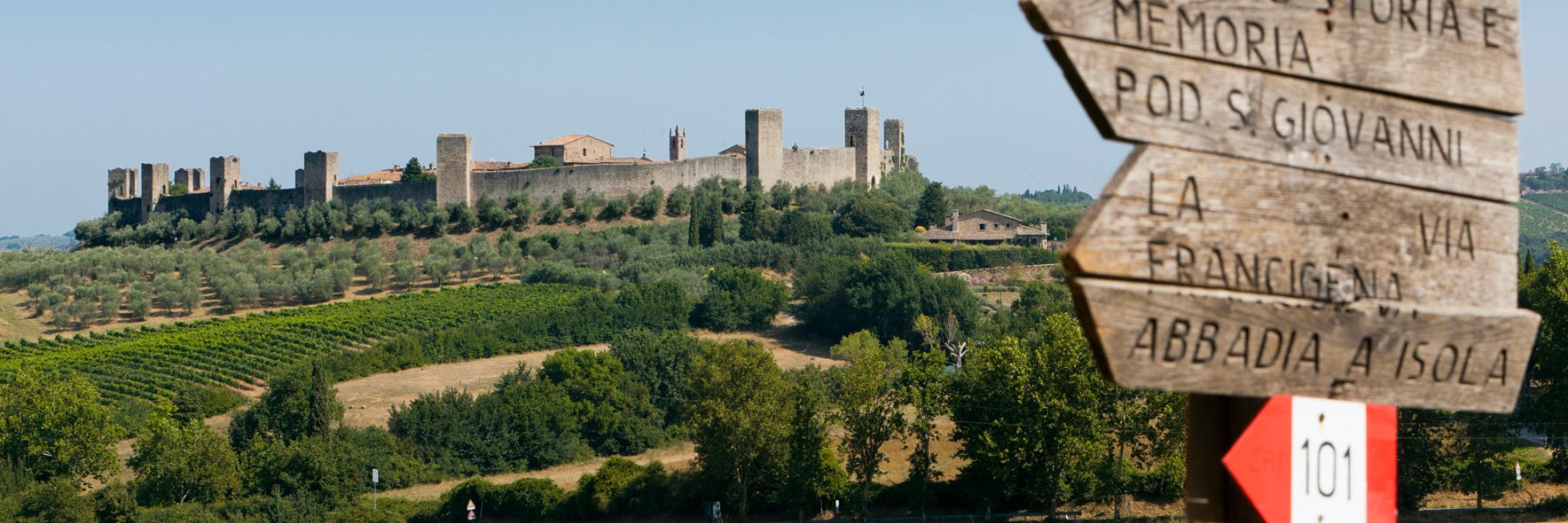Sito ufficiale della Francigena Toscana ©2026
Scorri in basso per cambiare lingua


In the footsteps of medieval pilgrims: a walk through nature, surrounded treasures of art and history
It was the year 990 when Sigeric, the Archbishop of Canterbury, travelled to Rome to receive his pallium from the pope. On his return, Sigeric made notes of all the stops he made, which he called submansiones, in his travel diary, today an immensely important historic testimony that allows us to reconstruct what was very likely the most treaded pilgrimage path around the year 1000. But the history of the Francigena is more than just Sigeric’s words, and stretches even further back in time. The origins of the route date to the Lombards, who by the 6th century were crossing Monte Bardone, between Berceto and Pontremoli, near what is today Passo della Cisa, a secure route for reaching the historic maritime destination of Luni and Tuscia, far from the routes controlled by the Byzantines, their undeniable enemies.
With the Franks and the Carolingians, the road became a major communication route that, around Lucca, turned towards Altopascio, crossed over the Arno River, and continued through the Val d’Elsa all the way to Siena. From here, following the Cassia, the road passed through the Val d’Arbia and Val d’Orcia on its way to Rome. The via Francigena wound through the main towns of the era, connecting sacred places in Christendom on the peninsula. Over the years, monuments and artistic treasures enriched the key stops on the route, like the splendid cathedral in Lucca, the Hospital of Santa Maria della Scala in Siena and the precious reliquaries conserved in churches along the way. The road allowed for communication between the Mediterranean and the North Sea and was soon travelled by men and goods, contributing to the rebirth of European trade.
Today, the walk is an important cultural itinerary linking Canterbury and Rome, sustained by the thrill of discovering traces left over the centuries, of traversing unspoilt landscapes dotted with artistic treasures, of encountering the traditions of various places along the way. The itinerary winds through areas with little to no industrialization, and for this reason, it’s perfect for shaping the mind’s range of imagination.
Slow travel – Walking the Tuscan stretch of the via Francigena at the slow pace of a wayfarer, pilgrims travel an itinerary brimming with history and traditions. From Passo della Cisa to Pontremoli, along a mule track that winds through forests and medieval atmospheres before reaching the splendid Parish Church of Sorano in Filattiera, and later from Aulla to the sea. The route continues through fortified towns, all the way to Massa and Pietrasanta, in the Versilia, and on to the Apuan Alps, before coming to Lucca. The journey encourages contact with nature and people. Pilgrims can stop to meditate, discover, understand art, history, culture, nature and the religiosity of the places.
Continuing through the valleys in central Tuscany, between Altopascio and Fucecchio, the road crosses the Arno River and comes to the historic town of San Miniato. Passing through scenic hills in the Val d’Elsa, in a continuous up and down, surrounded by hills dotted with vineyards, olive groves and cultivated fields, the Francigena eventually arrives in San Gimignano. Through the city of Siena, down the white roads of the Val d’Arbia and past Buonconvento, the route reaches the Val d’Orcia and the medieval fortified village of San Quirico d’Orcia. The via Francigena then leaves Tuscany behind as it dives into Lazio just after passing by the town of Radicofani.
The via Francigena is a route that, for its beauty and ability to evoke emotion, is a paradigm of the new trend of slow travel, its itinerary – on foot, on horseback, by bike or even by car – becoming an internal journey, one for the spirit, whether the pilgrim is religious or not, enriched with history and personal experience, a cultural and environmental opportunity that allows for conscious tourism that’s respectful of territories and their people.